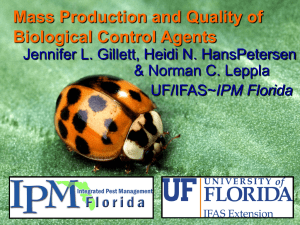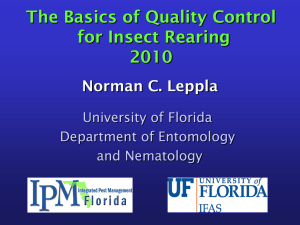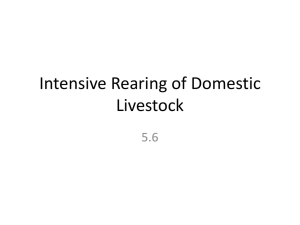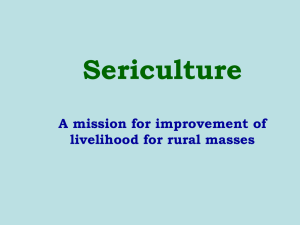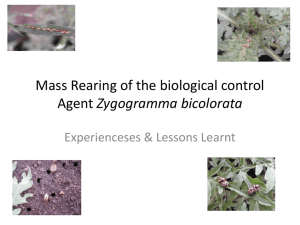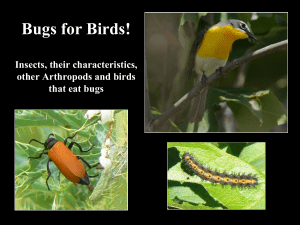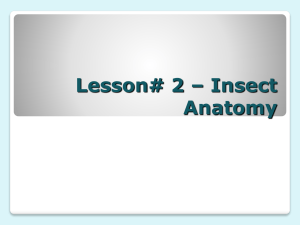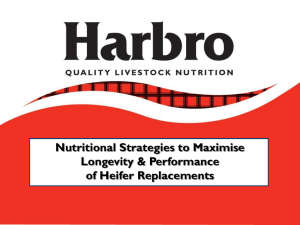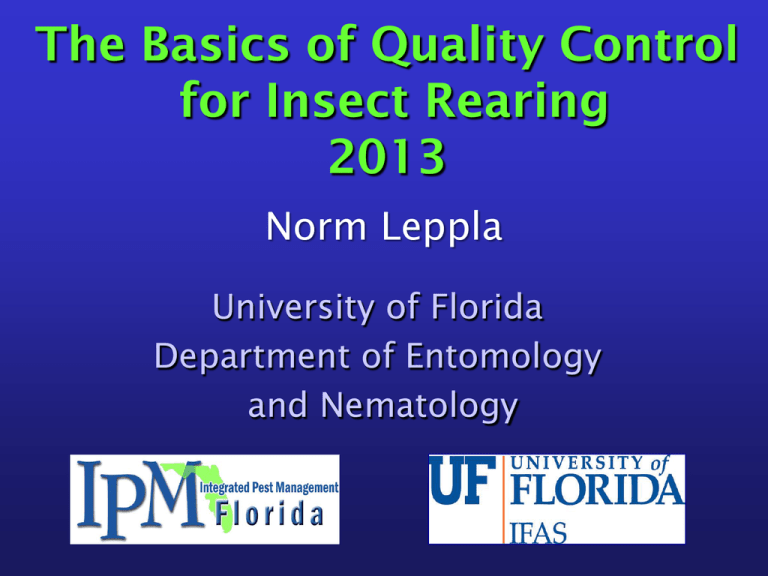
The Basics of Quality Control
for Insect Rearing
2013
Norm Leppla
University of Florida
Department of Entomology
and Nematology
I. Introduction
Norm’s Career in Insect Rearing
• University of Arizona- Insect rearing research, 2 years
• USDA, ARS- Insectary management, Florida and Texas,
17 years
• USDA, APHIS- Methods development, Washington DC
and international, 7 years
• University of Florida- Integrated pest management and
Biological Control, 16 years
• Chemical ecology and quality of Spalangia cameroni
(Erika Machtinger)
• Rearing and quality of Tamarixia radiata (Chris Kerr)
Countries of Workshop Students
Quality Control Topics
I.
II.
III.
IV.
V.
VI.
Introduction- Learning how to
rear quality insects
Colony Establishment and
Maintenance
Monitoring Quality
Evaluation and Management
Guidelines for Quality Systems
Total Quality Management
Learning How to Rear High
Quality Insects
•Apprentice in an insectary
•Network with other professionals
•Literature plus trial-and-error
•Visit other insectaries
•Reviews by experts
•Education and Training programs
MSU Insect Rearing Workshop
Frank Davis
John Schneider
Online Rearing Courses2013
•An Introduction
to Insect
Rearing
•Physical Aspects of Insect
Rearing
•Biological Aspects of Insect
Rearing
•Following Insectary SOPs:
How and Why?
http://insectdiets.com
2004
Insectary
Manager
Network
Anyone associated with the mass
rearing of insects
65 Members
http://www.entsoc.org/
Insect Rearing Professionals
Google Group
Subscribe:
(leonwesterd@gmail.com)
Léon Westerd
Group moderator
Head of insect rearing
Wageningen UR, Netherlands
VI. Total Quality Management
Parts of an Insect Rearing System
Generic Guidelines for
Quality Systems
•Policy, Planning and Administration
•Design Assurance and Change Control
•Control of Purchased Materials
•Production Quality Control
•User Contact and Field Performance
•Corrective Action
•Employees- Select, Train and Motivate
A Complete QA System
Quality Assurance Actions
Production and Process Control
Frequency of Actions
Routinely
Have up-to-date standard operating procedures
Periodically
X
Use check sheets to monitor rearing processes
X
Record daily production data
X
Track changes in production
X
Review production with staff
X
Improve product quality based on staff feedback
X
Product Control
Conduct product quality control assessments
X
Have established minimum thresholds of quality
X
Use standard shipping and handling procedures
X
Customer Service
Add customer feedback forms to shipments
X
Add product use instructions to shipments
X
Have an established customer service program
X
Improve product quality based on customer feedback
X
Possibly
Quality Assurance Actions
Research
Frequency of Actions
Routinely
Periodically
Possibly
Maintain internal methods improvement
X
Conduct publishable research
X
Communicate research needs to outside researchers
X
Collaborate with researchers without funding projects
X
Contract for research and provide funding
X
Outreach
Provide materials for training activities
X
Provide products for training activities
X
Participate in training activities
X
Describe quality assurance program
X
II. Colony Establishment and
Maintenance
II. A. Purposes for Rearing Insects
II. B. Types of Insect Rearing Systems
II. C. Options for Colonizing Insects
II. D. Maintaining the Quality of
Colonized Insects
II. A. Purposes for Rearing Insects
White witch,
Thysania
agrippina
(Lepidoptera:
Noctuidae
II. B. Types of Insect
Rearing Systems
Painted Lady
Monarch
Small-Scale Rearing: Butterflies
Annie Lorie
“Insect rearing is never a
boring task; insects are
always doing something
interesting and pose new
challenges all the time”
Punky
Rogers
Medium-Scale
Rearing
Mass Rearing- Medfly
El Pino,
Guatemala
Capacity- 3.5 billion sterile
male pupae per week
Metapa, Mexico
Honolulu, Hawaii
Nori Tanaka
II. C. Options for Colonizing
Insects
Peter Ebling
Insect Producer Database Mgr.
Great Lakes Forestry Centre
1219 Queen St. East
Sault Ste. Marie, ON P6A 2E5
peter.ebling@nrcan.gc.ca
(705) 541-5517
•World-wide listing,
35 insect & 21
nematode orders
•Data submitted by
sources
•Searchable
database
•Expand clients
•Adopt-a-colony
http://www.insect.glfc.cfs.nrcan.gc.ca
Field Collecting
Cabbage Loopers
Continuous Improvement of
Insect Rearing Capability
II. D. Maintaining the Quality
of Colonized Insects
Maintaining the Quality of
Colonized Insects
•Collection of appropriate biotypes
•Colonization and strain
development
•Rearing proficiency
•Colony management
•Optimization
III. Monitoring Quality
III. A. Quality Control Criteria
and Standardized Tests
III. B. Sampling for Consistent
Quality
III. C. Production, Process and
Product Control
III. A. Quality Control Criteria
and Standardized Tests
•Quantity- Number of Pupae or Adults
•Size- Weight of Pupae
•Fecundity- Oviposition and Egg Hatch
•Rate of Development-Synchronization
•Adult Behavior-Flight, Longevity
•Field Performance- Achieve Purpose
Specifications- Requirements for
a product or service
Standards- The level of quality at
which a specification is written
III. B. Sampling for
Consistent Quality
Count = Measurement = N
Mean = Sum/Number of Counts = X
Variance = Sum of (N – X)2 / n-1 =
2
Standard Deviation = Square Root of
2=
SD
Number of Cabbage Looper
Pupae Per Rearing Container
Container
1
2
3
4
5
6
1
175
157.6
17.4
302.76
190
190
191
180
142
2
167
157.6
9.4
88.36
191
191
190
180
176
3
144
157.6
-13.6
184.96
191
190
192
189
156
4
166
157.6
8.4
70.56
191
192
190
176
138
5
136
157.6
-21.6
466.56
190
191
190
174
181
Average
157.6
190.6
190.8
0.5
0.8
Sum of
Squares
Variance
1,113.2
Standard
Deviation
16.7
Shelf 1 is lowest
190.6 179.8 158.6
278.3
0.9
5.8
19.4
Quality Control Charts
III. C. Production, Process
and Product Control
IV. Evaluation and Management
IV. A. Structured Diagnostic
Procedures
IV. B. Quality Control versus
Methods Improvement
IV. C. Periodic Review
IV. A. Structured Diagnostic
Procedures
IV. B. Quality Control Versus
Methods Improvement
Quality Control
• Monitor indicator variables
• Evaluate multiple variables
• Troubleshoot using QC data
• Conduct evaluations rapidly
• Goal is to restore stable production
Methods Improvement
• Conduct evaluations methodically
• Test one variable at a time
• Use controlled experiments
• Test results in the production system
• Goal is to optimize production
Type of Research
Feasibility/market analysis
Mass production
Utilization
Application environment
Research Priorities
Natural enemy effectiveness in controlling target pests
Product development
Quality assurance systems
Rearing facilities
Mechanized equipment
Rearing materials
Natural and artificial diets
Rearing and harvesting techniques
Production quality control
Process quality control
Product quality control
Product handling and storage
Automated counting technology
Improved packaging and shipping
Extended use period
Efficient scouting techniques
Optimal release numbers, rates and timing
Mechanized application technologies
Efficient product evaluation procedures
Utilization quality control
Site-specific pest prevention
Systems to maximize the effectiveness of natural enemies
Natural enemy use with pesticides
Systems with multiple products and pests
Effectiveness in seasonal and perennial crops
Olivefly Methods Improvement
Bactrocera
oleae
FAO/IAEA Entomology Unit
Seibersdorf, Austria - 2009
Eggs hatched
Eggs/Cage
Eggs laid
Sex ratio male:female
Eggs Hatched
Total eggs laid
Eggs laid
Number of females
Eggs hatched
Total eggs laid
Eggs laid
Number of males
Olivefly Methods Improvement
IV. C. Periodic Review
V. Guidelines for Quality
Systems
IOBC
Global Quality Control
Programs
•Individual Companies
Customers
•International Standards
ISO 9000
IOBC Guidelines
•The Marketplace
Quality Products
International Organization
for Biological Control
Mission: to facilitate and advance
cost-effective rearing of
high quality insects and
other arthropods in
support of biological
control and integrated
pest management
http://www.amrqc.org
Workshops of the IOBC,
WGQC (AMRQC)
1982
1984
1986
1988
1991
1992
1993
1995
1998
2003
2007
2010
2013
Gainesville, Florida
Wadenswil, Switzerland
Guatemala City, Guatemala
Vancouver, Canada
Wageningen, Netherlands
Horsholm, Denmark
Rimini, Italy
Santa Barbara, California
Cali, Colombia
Montpellier, France
Montreal, Canada
Vienna, Austria
Bangalore, India
E. F. Boller and D. L. Chambers
E. F. Boller and D. L. Chambers
C. 0. Calkins
C. 0. Calkins
F. Bigler and J. C. van Lenteren
F. Bigler
M. Benuzzi and N. C. Leppla
R. F. Luck and N. C. Leppla
N. C. Leppla and T. R. Ashley
P. De Clercq, S. Grenier and NCL
S. Grenier and C. S. Glenister
P. De Clercq and T. A. Coudron
P. De Clercq and T. A. Coudron
Insect Pest
Control (IPC)
http://www-naweb.iaea.org/nafa/ipc/public/ipc-model-plansterile-insect-technique.html
Leppla’s Insect Rearing Quality
Control References
• Leppla, N. C. 2013. Quality Assurance for Mass-Reared
Parasitoids and Predators. In Mass Production of
Beneficial Organisms. Elsevier.
• Leppla, N. C. 2009. The basics of quality control for
insect rearing. In Principles and Procedures for
Rearing Quality Insects. Mississippi State University.
• Leppla, N. C. 2004, 2008. Rearing of Insects.
Encyclopedia of Entomology. Kluwer.
• Leppla, N. C. 2003. Guidelines for quality control of
commercially produced natural enemies. In Quality
Control and Production of Biological Control Agents,
Theory and Testing Procedures. CABI.
• Leppla, N. C. 2002, 2009. Rearing of Insects.
Encyclopedia of Insects. Academic Press.
For more information or a copy of
this presentation please visit:
http://ipm.ifas.ufl.edu

